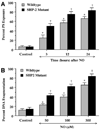The Src homology 2 domain tyrosine phosphatases SHP-1 and SHP-2: diversified control of cell growth, inflammation, and injury
- PMID: 17647198
- PMCID: PMC2515712
- DOI: 10.14670/HH-22.1251
The Src homology 2 domain tyrosine phosphatases SHP-1 and SHP-2: diversified control of cell growth, inflammation, and injury
Abstract
Interest in the diverse biology of protein tyrosine phosphatases that are encoded by more than 100 genes in the human genome continues to grow at an accelerated pace. In particular, two cytoplasmic protein tyrosine phosphatases composed of two Src homology 2 (SH2) NH2-terminal domains and a C-terminal protein-tyrosine phosphatase domain referred to as SHP-1 and SHP-2 are known to govern a host of cellular functions. SHP-1 and SHP-2 modulate progenitor cell development, cellular growth, tissue inflammation, and cellular chemotaxis, but more recently the role of SHP-1 and SHP-2 to directly control cell survival involving oxidative stress pathways has come to light. SHP-1 and SHP-2 are fundamental for the function of several growth factor and metabolic pathways yielding far reaching implications for disease pathways and disorders such as diabetes, neurodegeneration, and cancer. Although SHP-1 and SHP-2 can employ similar or parallel cellular pathways, these proteins also clearly exert opposing effects upon downstream cellular cascades that affect early and late apoptotic programs. SHP-1 and SHP-2 modulate cellular signals that involve phosphatidylinositol 3-kinase, Akt, Janus kinase 2, signal transducer and activator of transcription proteins, mitogen-activating protein kinases, extracellular signal-related kinases, c-Jun-amino terminal kinases, and nuclear factor-kappaB. Our progressive understanding of the impact of SHP-1 and SHP-2 upon multiple cellular environments and organ systems should continue to facilitate the targeted development of treatments for a variety of disease entities.
Figures




Similar articles
-
Src homology region 2 (SH2) domain-containing phosphatase-1 dephosphorylates B cell linker protein/SH2 domain leukocyte protein of 65 kDa and selectively regulates c-Jun NH2-terminal kinase activation in B cells.J Immunol. 2000 Aug 1;165(3):1344-51. doi: 10.4049/jimmunol.165.3.1344. J Immunol. 2000. PMID: 10903736
-
Dual signaling role of the protein tyrosine phosphatase SHP-2 in regulating expression of acute-phase plasma proteins by interleukin-6 cytokine receptors in hepatic cells.Mol Cell Biol. 1999 Aug;19(8):5326-38. doi: 10.1128/MCB.19.8.5326. Mol Cell Biol. 1999. PMID: 10409724 Free PMC article.
-
The tyrosine phosphatase SHP-2 is required for mediating phosphatidylinositol 3-kinase/Akt activation by growth factors.Oncogene. 2001 Sep 20;20(42):6018-25. doi: 10.1038/sj.onc.1204699. Oncogene. 2001. PMID: 11593409
-
SHP-2, SH2-containing protein tyrosine phosphatase-2.Int J Biochem Cell Biol. 1998 May;30(5):559-66. doi: 10.1016/s1357-2725(98)00002-8. Int J Biochem Cell Biol. 1998. PMID: 9693956 Review.
-
Role of the SHP-2 tyrosine phosphatase in cytokine-induced signaling and cellular response.Biochim Biophys Acta. 2002 Nov 11;1592(3):297-301. doi: 10.1016/s0167-4889(02)00322-1. Biochim Biophys Acta. 2002. PMID: 12421673 Review.
Cited by
-
Association of polymorphism of PTPN 11 encoding SHP-2 with gastric atrophy but not gastric cancer in Helicobacter pylori seropositive Chinese population.BMC Gastroenterol. 2012 Jul 12;12:89. doi: 10.1186/1471-230X-12-89. BMC Gastroenterol. 2012. PMID: 22788847 Free PMC article.
-
Angiotensin-II-induced apoptosis requires regulation of nucleolin and Bcl-xL by SHP-2 in primary lung endothelial cells.J Cell Sci. 2010 May 15;123(Pt 10):1634-43. doi: 10.1242/jcs.063545. Epub 2010 Apr 20. J Cell Sci. 2010. PMID: 20406888 Free PMC article.
-
Inhibition of SHP-1 activity by PKC-θ regulates NK cell activation threshold and cytotoxicity.Elife. 2022 Mar 8;11:e73282. doi: 10.7554/eLife.73282. Elife. 2022. PMID: 35258455 Free PMC article.
-
Intramolecular Interaction with the E6 Region Stabilizes the Closed Conformation of the N-SH2 Domain and Concurs with the Self-Inhibitory Docking in Downregulating the Activity of the SHP2 Tyrosine Phosphatase: A Molecular Dynamics Study.Int J Mol Sci. 2022 Apr 27;23(9):4794. doi: 10.3390/ijms23094794. Int J Mol Sci. 2022. PMID: 35563185 Free PMC article.
-
Crosstalk Between Prostate Cancer Cells and Tumor-Associated Fibroblasts Enhances the Malignancy by Inhibiting the Tumor Suppressor PLZF.Cancers (Basel). 2020 Apr 27;12(5):1083. doi: 10.3390/cancers12051083. Cancers (Basel). 2020. PMID: 32349303 Free PMC article.
References
-
- Akagi S, Ichikawa H, Okada T, Sarai A, Sugimoto T, Morimoto H, Kihara T, Yano A, Nakao K, Nagake Y, Wada J, Makino H. The critical role of SRC homology domain 2-containing tyrosine phosphatase-1 in recombinant human erythropoietin hyporesponsive anemia in chronic hemodialysis patients. J. Am. Soc. Nephrol. 2004;15:3215–3224. - PubMed
-
- Alonso A, Sasin J, Bottini N, Friedberg I, Osterman A, Godzik A, Hunter T, Dixon J, Mustelin T. Protein tyrosine phosphatases in the human genome. Cell. 2004;117:699–711. - PubMed
-
- Altomare DA, Guo K, Cheng JQ, Sonoda G, Walsh K, Testa JR. Cloning, chromosomal localization and expression analysis of the mouse Akt2 oncogene. Oncogene. 1995;11:1055–1060. - PubMed
-
- Andersen JN, Jansen PG, Echwald SM, Mortensen OH, Fukada T, Del Vecchio R, Tonks NK, Moller NP. A genomic perspective on protein tyrosine phosphatases: gene structure, pseudogenes, and genetic disease linkage. FASEB J. 2004;18:8–30. - PubMed
-
- Aoki Y, Huang Z, Thomas SS, Bhide PG, Huang I, Moskowitz MA, Reeves SA. Increased susceptibility to ischemia-induced brain damage in transgenic mice overexpressing a dominant negative form of SHP2. FASEB J. 2000;14:1965–1973. - PubMed
Publication types
MeSH terms
Substances
Grants and funding
LinkOut - more resources
Full Text Sources
Other Literature Sources
Miscellaneous
